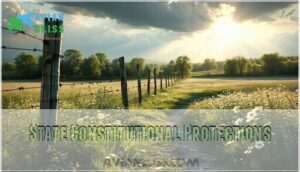This site is supported by our readers. We may earn a commission, at no cost to you, if you purchase through links.

This doctrine allows police to search vacant lots, farmland, and wilderness areas without warrants, even if you own the land. Courts distinguish these spaces from "curtilage", the protected area immediately around your home.
The rule stems from a 1924 Supreme Court decision that reasoned people can’t expect privacy in areas visible to the public. However, state courts increasingly challenge this federal precedent, creating a patchwork of protections across different jurisdictions that varies dramatically depending on where you live.
Table Of Contents
- Key Takeaways
- Open Fields Definition
- Curtilage and Privacy
- Aerial Surveillance Rules
- State Constitutional Protections
- Frequently Asked Questions (FAQs)
- What is an open field?
- Are open fields protected?
- Where did the open fields doctrine come from?
- What are examples of open fields?
- What is the difference between open fields and curtilage?
- Are there limits to open fields?
- What is considered an open-field?
- What is the open-field in the Bible?
- What is the difference between curtilage and open fields?
- How do open fields affect local climate patterns?
- Conclusion
Key Takeaways
- You can’t expect Fourth Amendment privacy protection on most of your property – law enforcement can search pastures, woods, and vacant lots without warrants, even if you’ve posted "No Trespassing" signs
- Your home’s immediate area (curtilage) receives constitutional protection, but open fields beyond this zone don’t – courts use a four-factor test considering proximity, enclosure, use, and observation protection to determine boundaries
- Police can conduct aerial surveillance and photography of your property from navigable airspace without warrants – what you can see with the naked eye from legal flight altitudes is fair game for evidence collection
- Seven states have rejected the federal open fields doctrine under their state constitutions, offering stronger privacy protections – you’ll find varying property rights depending on where you live, with some states requiring warrants even for distant private land
Open Fields Definition
You might be surprised to learn that the Fourth Amendment doesn’t protect every inch of your property from government searches.
When law enforcement steps onto what courts call "open fields," they’re operating in a legal gray area where your privacy expectations don’t carry the same weight as they do inside your home.
Fourth Amendment Protections
Why does the Fourth Amendment matter to you?
It guarantees security in your persons, houses, papers, and effects against unreasonable searches and seizures.
Law enforcement can’t just barge onto your property without Search Warrants backed by Probable Cause.
This Constitutional Law protection shields your Privacy Rights from warrantless searches, ensuring Court Rulings uphold reasonable expectations of privacy.
Exceptions to Protections
While the Fourth Amendment shields you from unreasonable search and seizure, several exceptions exist.
These carve-outs allow warrantless search under specific circumstances, balancing individual Privacy Rights against law enforcement needs. Understanding these exceptions helps you recognize when Seizure Laws apply differently.
Key exceptions include:
- Border Searches – Customs agents can search without warrants at international entry points
- Exigent circumstances – Emergency situations where waiting for Warrant Requirements would compromise evidence or safety
- Plain view doctrine – Officers can seize evidence visible during lawful presence
- Consent searches – Voluntary permission eliminates Fourth Amendment protections
These exceptions create significant Search Limits, often rendering the exclusionary rule ineffective when evidence gets collected through these legal pathways.
Open Fields Doctrine
When law enforcement can’t get Search Warrants for your property, they might rely on the Open Fields Doctrine instead.
This Fourth Amendment exception allows warrantless search of areas like pastures, woods, and vacant lots on private land.
Unlike your home’s curtilage, these spaces lack reasonable expectation of Privacy Rights.
Even "No Trespassing" signs won’t stop Border Patrol or police from conducting Field Searches, making this doctrine controversial for advocates concerned about Digital Surveillance expansion.
History and Development
During Prohibition, you’d find law enforcement struggling with bootleggers hiding operations on private rural lands.
When bootleggers turned remote properties into hidden distilleries, federal agents needed new legal tools to pursue them.
The 1924 Supreme Court created the Open Fields Doctrine in Hester v. United States, ruling that Fourth Amendment protections don’t extend to "open fields" beyond homes.
This Constitutional Interpretation emerged from Legislative Background targeting alcohol enforcement, establishing Judicial Precedents that allowed warrantless searches.
The Doctrine Evolution expanded dramatically, with Historical Context showing nearly 96% of private U.S. land now exposed to government intrusion without warrants, fundamentally reshaping privacy expectations in constitutional law.
The Open Fields Doctrine raises concerns about warrantless search practices and their impact on private property rights.
Key Court Cases
Several landmark Supreme Court decisions shaped the Open Fields Doctrine’s boundaries, creating precedents that law enforcement agencies rely on today.
You’ll encounter these cases in most Fourth Amendment discussions involving property searches.
- Hester v. United States (1924) – Established the original Open Fields Doctrine, ruling that Fourth Amendment protections don’t extend to open fields
- Oliver v. United States (1984) – Reaffirmed the Hester Case, confirming that "No Trespassing" signs don’t create privacy expectations in open fields
- United States v. Dunn (1987) – Created the four-factor Dunn Test to distinguish curtilage from open fields using proximity, enclosure, use, and observation protection
- California v. Ciraolo (1986) – Extended the doctrine to aerial surveillance, allowing naked-eye observation from aircraft in navigable airspace
Implications for Law Enforcement
The open fields doctrine grants you unprecedented investigative freedom, allowing warrantless access to approximately 96% of private land across America.
You can deploy surveillance cameras, conduct aerial reconnaissance, and gather evidence without judicial oversight.
However, you’ll face increasing public resistance and must navigate complex state constitutional variations that may restrict your enforcement strategies and evidence admissibility in court proceedings.
The doctrine relies on federal search laws to justify warrantless searches on private property, which is a significant aspect of investigative freedom and evidence admissibility.
Curtilage and Privacy
While the open fields doctrine strips Fourth Amendment protections from most private property, the area immediately surrounding your home receives different treatment.
This zone, called curtilage, maintains constitutional protections but operates under specific rules that determine when you can expect privacy and when law enforcement can lawfully observe your activities.
Definition of Curtilage
Your home isn’t just the four walls where you sleep—it extends to the area immediately surrounding it, known as curtilage.
This legal concept defines where your Fourth Amendment protections against unreasonable search and seizure truly begin, creating a buffer zone between your private residential space and the unprotected open fields beyond.
- Curtilage Boundaries encompass driveways, porches, patios, and nearby sheds or garages
- Home Security depends on understanding these invisible property lines that law enforcement must respect
- Residential Areas receive stronger constitutional protections than commercial properties or distant land parcels
Unlike open fields where police can freely roam without warrants, curtilage maintains your reasonable expectation of privacy.
Property Rights within this zone mean officers generally need probable cause before crossing these boundaries, making Land Use patterns around your home legally significant for constitutional protection.
Four-Factor Test
When figuring out curtilage, you’ll use the four-factor test: Proximity Analysis checks how close the area is to your home, Enclosure Types look for fences or walls, Land Use examines daily activities, and Observation Methods measure steps taken to block views.
These Privacy Boundaries help courts decide if an area is protected, unlike open fields under the Fourth Amendment’s search and seizure rules.
Privacy Expectations
Privacy expectations within curtilage aren’t absolute shields against government intrusion.
You won’t find automatic Fourth Amendment search protections just because you’ve erected barriers or posted signs.
Courts examine whether your reasonable expectation of privacy exists under current surveillance laws and Digital Privacy frameworks.
Even high fences can’t block aerial observation or protect against Data Protection gaps.
Personal Boundaries require understanding when Information Security meets constitutional limits.
Aerial Surveillance Rules
While you might think your backyard activities are private, aerial surveillance laws say otherwise.
Government aircraft can legally observe and photograph your property from above, even if you’ve built fences or posted signs.
Naked-Eye Observation
Law enforcement’s aerial surveillance through naked eye observations from aircraft flying in navigable airspace doesn’t violate your Fourth Amendment rights.
You can’t expect privacy for outdoor activities when officers use basic visual observation from planes at legal altitudes.
The plain view doctrine applies here – if police can see illegal activity without enhanced technology, that evidence stands in court.
Your visibility limits don’t extend skyward.
Understanding aerial surveillance techniques is essential in evaluating the effectiveness of such operations.
Helicopter Surveillance
Helicopters conducting aerial surveillance over open fields operate under different constitutional standards than ground-based searches.
Courts generally permit warrantless helicopter surveillance when conducted from lawful altitudes and airspace.
Here are five key factors courts consider for helicopter surveillance:
- Flight altitude – Must comply with FAA regulations and maintain reasonable height
- Airspace legality – Operations must occur within publicly navigable airspace boundaries
- Surveillance duration – Extended hovering may indicate unreasonable intrusion levels
- Noise and disruption – Excessive disturbance can transform observation into constitutional violation
- Target location – Open fields receive minimal protection versus curtilage areas
The Supreme Court’s Florida v. Riley decision established that helicopter surveillance at 400 feet doesn’t violate Fourth Amendment protections.
However, extremely low altitude flights or prolonged hovering may cross constitutional boundaries, requiring warrant requirements for such airborne spying activities.
Law enforcement often utilizes helicopter camera systems to gather evidence in these operations.
Aerial Photography
Courts have ruled aerial photography doesn’t violate Fourth Amendment protections when conducted from navigable airspace.
Your commercial facility’s security fences won’t shield you from overhead surveillance tech – law enforcement can capture photo evidence using drone usage or aerial mapping without warrants.
The Plain View Doctrine extends skyward, making open fields observations from aircraft perfectly legal.
Flight regulations determine permissible altitudes for aerial surveillance operations.
Photographers must consider low light techniques to capture high-quality images in various conditions.
State Constitutional Protections
While the federal Fourth Amendment’s open fields doctrine often leaves property owners exposed to warrantless searches, you’ll find that state constitutions can offer stronger privacy protections.
Seven states have already rejected this doctrine under their own constitutional frameworks, creating a patchwork of varying property rights across the nation, which highlights the importance of state constitutions.
Greater Protections Against Searches
While federal courts limit Fourth Amendment protections through open fields doctrine, you’ll find many states offer stronger privacy safeguards.
More than fifteen states prohibit warrantless searches of open fields, with Texas and Montana requiring search warrants even beyond curtilage boundaries.
Pennsylvania, Alaska, and Tennessee extend constitutional privacy protections to private land, ensuring probable cause requirements.
These enhanced state protections shield digital privacy concerns and strengthen evidence admissibility standards against surveillance laws violations.
Understanding current privacy laws is essential for addressing the challenges of search and seizure regulations.
Rejection of Open Fields Doctrine
Seven states have broken free from federal limitations by rejecting the open fields doctrine under their state constitutions.
These pioneering jurisdictions include:
- Mississippi and Vermont – explicitly protect "possessions" in their constitutional text
- Montana, New York, Oregon – expanded privacy rights beyond Fourth Amendment minimums
- Tennessee and Washington – strengthened property protections against warrantless searches
This state rejection creates constitutional challenges to Oliver v United States, establishing broader privacy rights than federal courts recognize.
Pending Lawsuits and Challenges
Currently, you’re witnessing unprecedented legal challenges targeting warrantless searches on private land across multiple states.
Pending lawsuits in Tennessee, Kentucky, and Pennsylvania challenge law enforcement’s search powers under open fields doctrine, arguing state constitutional protections exceed Fourth Amendment baselines.
These court rulings could reshape how courts view warrantless seizures, with civil liberties groups filing amicus briefs supporting landowners’ constitutional protections against unreasonable government intrusion.
The ongoing debates highlight the importance of understanding rural landscapes and open field habitats in the context of search and seizure laws.
Frequently Asked Questions (FAQs)
What is an open field?
Under Fourth Amendment law, you’ll find that an "open field" means any unoccupied or undeveloped area outside your home’s immediate surroundings.
Including pastures, woods, vacant lots, and bodies of water, where you can’t expect privacy.
Are open fields protected?
No, open fields aren’t protected under the Fourth Amendment.
You can’t expect privacy in pastures, wooded areas, or vacant lots, even if you’ve fenced them and posted "No Trespassing" signs everywhere, because open fields are not considered private spaces.
Where did the open fields doctrine come from?
The doctrine originated from the 1924 Supreme Court case Hester v. United States, which established that you can’t expect Fourth Amendment privacy protections in open fields on private property.
What are examples of open fields?
Like surveying an unmarked field from your property line, you can’t claim privacy where boundaries blur into nature’s domain.
Open fields include pastures, wooded areas, vacant lots, bodies of water, and outbuildings—regardless of fencing or "No Trespassing" signs you’ve posted.
What is the difference between open fields and curtilage?
Curtilage is your home’s immediate surrounding area that receives Fourth Amendment protection, while you’ll find no privacy expectations in open fields beyond this zone.
Courts determine curtilage using proximity, enclosures, use, and protective steps taken.
Are there limits to open fields?
You can’t just wander anywhere claiming "open fields" protection—there are distinct boundaries that’ll make or break your case.
The doctrine doesn’t apply to curtilage (your home’s immediate surroundings) or areas where you’ve legitimately established privacy expectations through proper enclosures, which is a crucial point to consider for privacy expectations.
What is considered an open-field?
Under law, you’re looking at pastures, wooded areas, vacant lots, bodies of water, and outbuildings on your property that aren’t directly connected to your home’s immediate living area.
What is the open-field in the Bible?
Biblical open fields refer to cultivated agricultural land outside village boundaries where you’d grow crops like wheat, barley, and vegetables.
These areas weren’t privately owned but were communally managed, representing God’s provision for sustenance.
What is the difference between curtilage and open fields?
Your property’s protected area directly surrounding your home receives Fourth Amendment protection, while distant fields, pastures, and wooded areas don’t, allowing warrantless police searches.
How do open fields affect local climate patterns?
When you’re exploring large open areas, you notice they create unique microclimates by allowing unobstructed wind flow, temperature variations, and moisture patterns.
That differ substantially from surrounding forested or developed regions, creating a distinct environment shaped by these factors, including unobstructed wind flow.
Conclusion
Like a constitutional chess game with constantly shifting rules, the open fields doctrine remains one of law enforcement’s most contentious tools.
You’ll find yourself traversing a complex legal landscape where federal precedent clashes with evolving state protections.
While courts originally designed this doctrine to balance public safety with privacy rights, modern surveillance technology challenges its foundational assumptions.
Your property rights and privacy expectations depend heavily on your jurisdiction’s specific interpretations, making legal awareness essential for understanding your constitutional protections.
- https://congressionalsportsmen.org/policy/open-fields-doctrine/
- https://digitalrepository.unm.edu/cgi/viewcontent.cgi?article=2121&context=nmlr
- https://scholarship.law.georgetown.edu/cgi/viewcontent.cgi?article=3680&context=facpub
- https://statecourtreport.org/our-work/analysis-opinion/states-may-close-open-fields-exception-fourth-amendment
- https://en.wikipedia.org/wiki/Open-fields_doctrine










